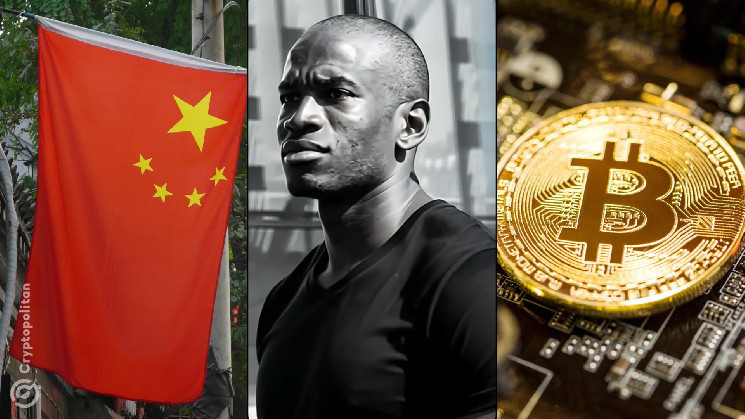Arthur Hayes, the brain behind BitMEX and Maelstrom, thinks China’s plans for economic stimulation and “quantitative easing” (QE) will work wonders for Bitcoin.
Hayes sees China pushing the yuan back into circulation while creating a new lifeline for Bitcoin. The government, led by Xi Jinping, recently clamped down on property developers and cut off reckless borrowing through policies like the “Three Red Lines.”
But now, as China faces its worst economic downturn in years, Hayes thinks they’ll resort to QE, pumping cash into the economy to support growth. He calls it “monetary chemotherapy.”
The property bubble hits the fan
China’s economic setup relies heavily on real estate. Local governments lease land to developers, and the money from these leases supports government budgets.
But the property bubble burst in 2020. Construction froze, Evergrande and other big developers defaulted, and banks ended up with useless property loans. China’s middle class, whose wealth is mostly tied to property, saw values drop sharply.
With youth unemployment through the roof and a slowing economy, Hayes thinks China will now go full throttle on QE to keep the economy moving.
Developers had been selling homes years before they were built, using early payments to fund construction. This turned into a Ponzi-like scheme. When loans dried up, construction stopped, and homebuyers were left with nothing.
The central government ordered banks to help finish these half-built homes, but local officials, afraid of being charged with corruption, mostly sat on their hands.
Hayes sees this inaction as the tipping point pushing China towards QE. Without more cash in the system, the property market and the economy will stay stuck.
“Monetary Chemo” and the Bitcoin link
Hayes describes China’s upcoming QE as “monetary chemotherapy,” saying it’s like treating cancer by pumping cash directly into the economy. The People’s Bank of China (PBOC) has already started, quietly buying up local government bonds.
This is the beginning of an all-out money-printing spree. By buying government debt, the PBOC will make it easier for the government to spend big and keep zombie companies afloat.
More cash in the economy means more inflation, and in Hayes’s eyes, that makes Bitcoin the ultimate hedge, just like he said in our exclusive interview earlier this month.
The PBOC has moved about CNY 3 trillion into local bonds recently. It’s a big shift, and while they avoid calling it QE, that’s exactly what it is. The U.S., Japan, and Europe all tried similar strategies after their financial crises. They learned fast that QE works best when you print loads of money.
Beijing still hates Bitcoin – but can’t stop it
Bitcoin trading in China still thrives, but under the radar. While the government banned formal yuan-Bitcoin exchanges in 2017, people found ways around it. Big exchanges like Binance and OKX now run peer-to-peer platforms, helping people convert yuan to Bitcoin without direct trading pairs.
Hayes says Beijing may have shut down official yuan-Bitcoin exchanges to hide the impact of their money-printing. With Bitcoin, people can protect their wealth without depending on real estate or the yuan.
Bitcoin remains a discreet way to escape inflation, and despite the ban on direct exchanges, peer-to-peer platforms keep it alive. Local traders facilitate yuan-to-Bitcoin trades, and platforms act as message boards.
Hayes calls it “Sino-LocalBitcoins,” highlighting how China’s resourceful traders make it work. This underground market is well-known, and Hayes sees it as proof that when inflation bites, Chinese citizens will turn to Bitcoin. They’ve done it before and, given the government’s stance on QE, they’ll do it again.
The yuan holds steady — for now
Unlike the dollar or the euro, China’s currency isn’t likely to collapse. Hayes explains that the yuan’s relative stability comes from China’s trade surplus and its ability to buy resources in yuan, thanks to deals with countries like Russia and Saudi Arabia.
China’s trade surplus is at an all-time high. But here’s the twist: it’s not because of increased exports but because they’re importing less. China’s factories now make more of what they used to import. And while China still needs to buy energy, it can now do so in yuan.
This setup buffers China from the dollar’s fluctuations. Even as they flood the economy with yuan, they won’t face the same currency crash other nations might after QE. They’ve got leverage, and Hayes doesn’t see a mass exodus from the yuan.
Unlike traditional assets, Bitcoin isn’t tied to any government’s economic policies, making it a safe bet when fiat currencies lose value. Hayes thinks China’s elite will realize this and turn to Bitcoin just as inflation takes off.
He insists it’s only a matter of time. The PBOC’s low-key bond buying is just the start. He recalls August 2015, when the yuan’s sudden devaluation led Bitcoin to spike from $135 to $600.
“No major risky asset class outperforms the debasement of the currency like Bitcoin does. Investors instinctively know this, and when it comes time to think about how to safeguard the purchasing power of your savings, Bitcoin will be staring back at you like the Kwisatz Haderach,” said Hayes.

